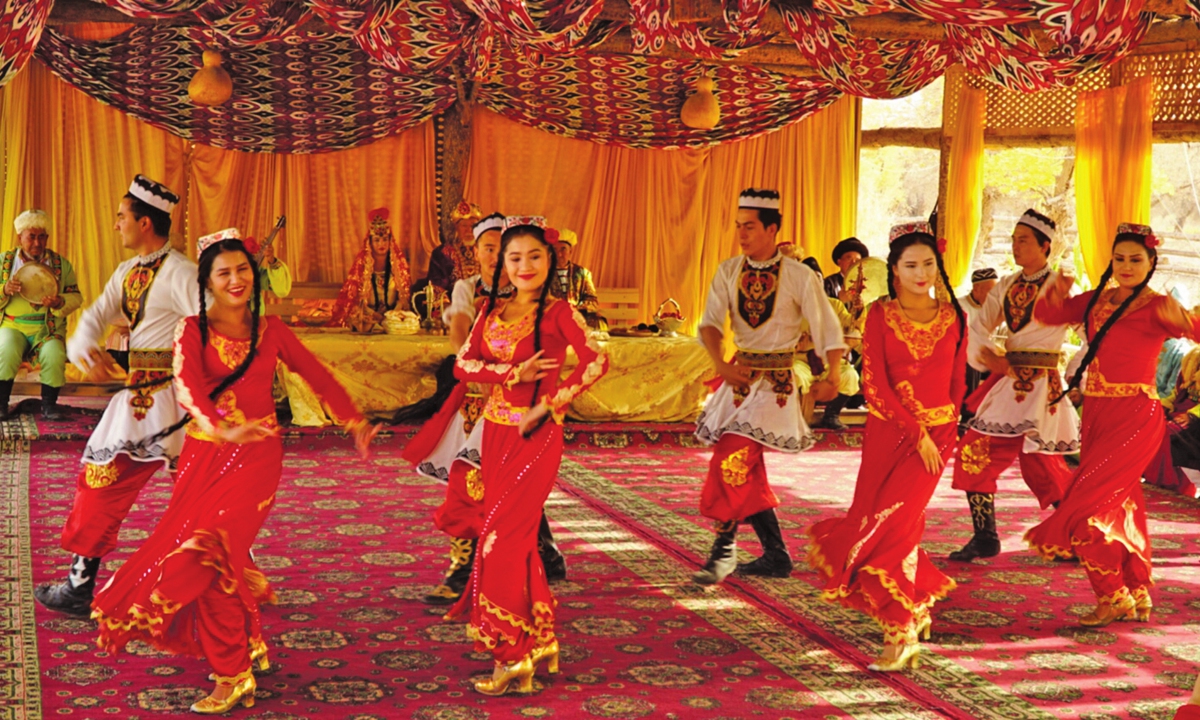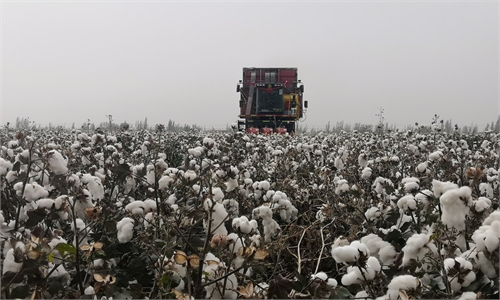Xinjiang embraces visitors with better natural environment, united ethnic groups and a safer society
Coming together

The Rainbow Beach in Burqin county, Altay Prefecture, Xinjiang Photo: Ji Yuqiao/GT
"No one can say no to the charm of Xinjiang, and no one who has visited Xinjiang once can refuse to come here again," a tourist who has driven to Northwest China's Xinjiang Uygur Autonomous Region on three occasions and still longs to step into the wonderland told me, representing many voices.
Xinjiang attracted more than 7.6 million tourists over the 2021 National Day holiday, with tourism revenue reaching 4.73 billion yuan ($735 million).
From Urumqi to the Altay Prefecture, after traveling through various places in northern Xinjiang and speaking with the locals there, it clicked with me why Xinjiang had such an appeal for tourists, not just those in China, but from other parts of the world as well.
Those who enjoy natural scenery are enchanted by Xinjiang's landscapes, which include wetlands, forests and amazing geological formations, and the diverse folk customs that have blossomed throughout the region due to various ethnic groups uniting together also grab the attention of people who are interested in the cultural landscape.
Nighttime in Xinjiang is safer than most strangers have imagined. As a migration worker living in Urumqi for dozen of years said, people can open their bags without needing to worry about being robbed. Thanks to efforts to safeguarding stability, the night markets in Xinjiang have also become one of the highlights of local tourism.
Night fairs
Burqin county, next to the Haba river, has four night fairs that sell local snacks, such as toasted freshwater fish and handicraft items to tourists until midnight. The fairs are usually active from May to October and are called river levee night markets because of their special locations.

A woman sings at a night market in Burqin county, Altay Prefecture, Xinjiang. Photo: Ji Yuqiao/GT
Tourists who like night activities gather at these night markets to taste the local pike fish barbecue and Xinjiang alcohol, watch singing and dancing performances of the Kazak people, as well as wander around the Chinese-Russian style docks.
Besides tourists from other places, local residents also like gathering in the night markets after dinner, to walk around and sing with performers together.
There are more than 100 stalls at one night market, each stall staffed by about seven to eight employees, according to Peng Kang, county Party secretary. The night fairs help increase local employment rates and even some migration workers from Hotan Prefecture also find jobs at these fairs.
In the first half of 2021, around 2.53 million tourists visited the county, growing 89.28 percent year on year. The prosperity of the night markets benefits from the county's security efforts.
Peng said that there are 33 guard stations set up throughout the county, and three troop stations are dedicated to the night markets, ensuring social safety and stability.
Ethnic unity
Li Hongxiu, 66, opened a private museum with other residents in Hongdun, Altay Prefecture, to display the stories of ethnic unity among local residents from multiple ethnic backgrounds.

A dance performance in Aksu Prefecture, Xinjiang Photo: VCG
The museum is located in the neighborhood of Hongdun where Li lives. Its history can be traced back to the 1860s, when Li's predecessors, more than 40 Han families, arrived in the remote town from other provinces like North China's Shanxi Province and Northwest China's Gansu Province.
Living in the frontier town alongside Mongolian and Kazak nomads on the northern bank of the Khran River, ethnic Han people learned how to get along with the various other ethnic communities. One local resident who sang a Kazak song told the Global Times that he learned how to speak Kazakh and Mongolian in childhood as he played with friends from different ethnic groups every day.
The private museum displaying ethnic unity attracts visitors from around the country, especially from Altay and Urumqi. Liu Min, the local first Party secretary, said that Li would have to receive tours four times a day due to the big number of tourists before the outbreak of the COVID-19 epidemic.
Ecological tourism
As flocks of birds fly through the sky singing, some of them land on trees or reeds growing at the center of the wetlands. For just a moment, the branches of the trees become decorated with black birds grooming their feathers.
This common scene appears almost every day during the migration season in the National Wetlands Park in Manas county, Changji Hui Autonomous Prefecture.
The 89-square-kilometer park, established in 2016, is one of the most important stations for migratory birds, like swans and graylags, which often fly to warmer places from September to November and choose the park as a place to replenish their energy.
"Swans will arrive here in about a month from now," Liu Yongjun, leader of the protection and management team of the park, told me on Thursday.
Liu said that, because of improved ecological conditions throughout China and the establishment of the park, they have seen an increasing number of swans that have been tagged by foreign research institutes land here during the migration season.
There are over 20,000 wild birds in the wetlands park and bird species have reached 279, among which, the number of swans has risen from about 30 in 2016 to over 800 in 2020. Besides birds, other wild animals like foxes also inhabit in the park.
The popularity of the park has benefited the nearby village. To meet preferences of tourists from around the country, a tourism hub named Bajiahu (Eight Households) village was established.


